While it's the globe-trotting 400hp-plus, 38 (and now 41) tonne
Page 20
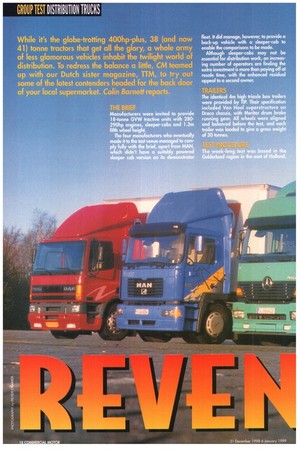
Page 21
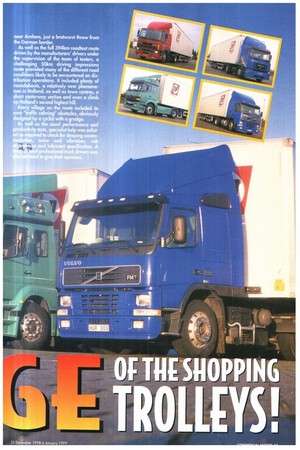
Page 22
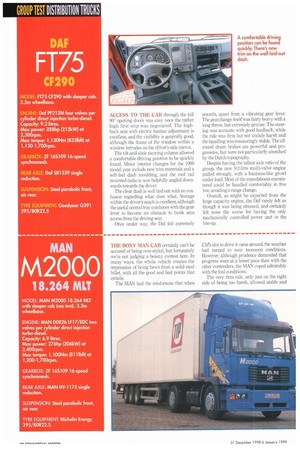
Page 23
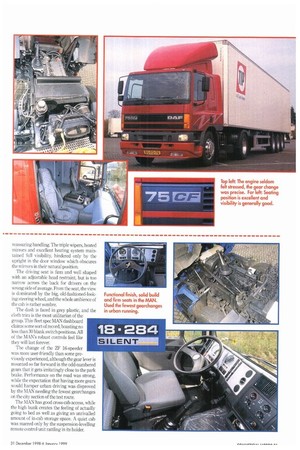
Page 24
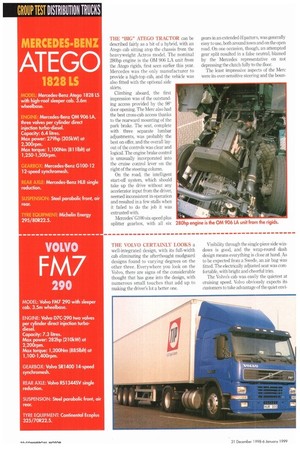
Page 25
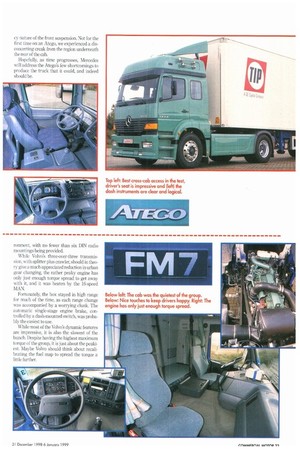
Page 27

If you've noticed an error in this article please click here to report it so we can fix it.
tractors that get all the glory, a whole army of less glamorous vehicles inhabit the twilight world of distribution. To redress the balance a little, CM teamed up with our Dutch sister magazine, TIM, to try out some of the latest contenders headed for the back door of your local supermarket. Colin Barnett reports_
nr+ir.r.
Manufacturers were invited to provide 18-tonne GVW tractive units with 280290hp engines, sleeper-cabs and 1.3m fifth wheel height.
The four manufacturers who eventually made it to the test venue monied to comply fully with the brief, apart from MAN, which didn't have a suitably powered sleeper cab version on its demonstrator fleet. It did manage, however, to provide a back-up vehicle with a sleeper-cab to enable the comparisons to be made. Although sleeper-cabs may not be essential for distribution work, an increasing number of operators are finding the extra investment is more than paying off at resale time, with the enhanced residual appeal to a second owner.
The identical 4m high triaxle box trailers were provided by TIP. Their specification included Van Hool superstructure on Draco chassis, with Mentor drum brake running gear. All wheels were aligned and balanced before the test, and each trailer was loaded to give a gross weight of 30 tonnes.
The week-long test was based in the Gelderland region in the east of Holland, near Arnhem, just a bratwurst throw from the German border.
As well as the full 394km roadtest route driven by the manufacturers' drivers under the supervision of the team of testers, a challenging 50km driving impressions route provided many of the different road conditions likely to be encountered on distribution operations. It included plenty of roundabouts, a relatively new phenomenon in Holland, as well as town centres, a short motorway section and even a climb up Holland's second highest hill. Every village on the route included its own "traffic calming" obstacles, obviously designed by a cyclist with a grudge. As well as the usual performance and productivity tests, specialist help was enlisted as required to check for sleeping accommodation, noise and vibration, cab eroomlomics and lubricant specification. A • ocal professional truck drivers was d to give their opinions.
DAF
FT75
CF290
FT75 CF290 with sleeper cab. 3.5m wheelbase.
Daf PF212M four valves per cylinder direct injection turbo-diesel. Capacity: 9.2 litres.
Max power: 288hp (212kW) at 2,30Orpm.
Max torque: 1,130Nm (833Ibft) at 1,150-1,700rpm.
GEARBOY ZF 165109 16-speed synchromesh.
REAR AXLE: Daf 5R1339 single
redudion.
SUSPENSION: Steel parabolic front, air rear.
TYRE EQUIPMENT: Goodyear G391
295/80R22.5 ACCESS TO THE CAB through the tall 90" opening doors was easy once the rather high first step was negotiated. The highback seat with electric lumbar adjustment is excellent, and the visibility is generally good, although the frame of the window within a window intrudes on the driver's side mirror.
The tilt-and-slide steering column allowed a comfortable driving position to be quickly found. Minor interior changes for the 1999 model year include new trim materials and a soft-feel dash moulding, and the roof rail mounted radio is now helpfully angled downwards towards the driver.
The clear dash is well laid out with no confusion regarding what does what. Storage within the driver's reach is excellent, although the useful central tray combines with the gear lever to become an obstacle to bunk area access froni the driving seat.
Once under way, the Daf felt extremely smooth, apart from a vibrating gear lever. The gearchange itself was fairly heavy with a long throw, but extremely precise. The steering was accurate with good feedback, while the ride was firm but not unduly harsh and the handling was reassuringly stable. The allround drum brakes are powerful and progressive, but were not particularly stretched by the Dutch topography.
Despite having the tallest axle ratio of the group, the new 92-litre multi-valve engine pulled strongly, with a business-like growl under load. Most of the roundabouts encountered could be handled comfortably in five low, avoiding a range change.
Overall, as might be expected from the large capacity engine, the Daf rarely felt as though it was being stressed, and certainly felt none the worse for having the only mechanically controlled power unit in the line-up.
MAN
M2000
18.264 MLT
MODEL: MAN M2000 18.264 MIT with sleeper cab (see text). 3.3m wheelbase.
ENGINE: MAN D0826 LF17/EDC two valves per cylinder direct injection turbo-diesel.
Capacity: 6.9 litres.
Max power: 276hp (206kW) at 2,40Orpm.
Max torque: 1,100Nm (811 Ibft) at 1,200-1,700rpm.
GEARBOX: ZF 165109 16-speed synchromesh.
REAR AXLE: MAN HY-1175 single reduction.
SUSPENSION: Steel parabolic front, air rear.
TYRE EQUIPMENT: Michelin Energy 295/80R22.5.
THE BOXY MAN CAB certainly can't be accused of being over-styled, but fortunately we're not judging a beauty contest here. In many ways, the whole vehicle creates the impression of being hewn from a solid steel billet, with all the good and bad points that entails.
The MAN had the misfortune that when
CNis slot to drive it came around, the weather had turned to near monsoon conditions. However, although prudence demanded that progress went at a lesser pace than with the other contenders, the MAN coped admirably with the foul conditions.
The very firm ride, only just on the right side of being too harsh, allowed stable and reassuring handling. The triple wipers, heated mirrors and excellent heating system maintained full visibility, hindered only by the upright in the door window which obscures the mirrors in their natural position.
The driving seat is firm and well shaped with an adjustable head restraint, but is too narrow across the back for drivers on the wrong side of average. From the seat, the view is dominated by the big, old-fashioned-looking steering wheel, and the whole ambience of the cab is rather sombre.
The clash is faced in grey plastic, and the cloth trim is the most utilitarian of the group. This fleet spec MAN dashboard claims some sort of record, boasting no less than 30 blank switch positions. All of the MAN's robust controls feel like they will last forever.
The change of the ZF 16-speeder was more user-friendly than some previously experienced, although the gear lever is mounted so far forward in the odd-numbered gears that it gets irritatingly close to the park brake. Performance on the road was strong, while the expectation that having more gears would hamper urban driving was disproved by the MAN needing the fewest gearchanges on the city section of the test route.
The MAN has good cross-cab access, while the high bunk creates the feeling of actually going to bed as well as giving an unrivalled amount of in-cab storage space. A quiet cab was marred only by the suspension-levelling remote control unit rattling in its holder.
MER EDE
ATEGO
1828L
Mercedes-Benz Atego 1828 LS with high-roof sleeper cab. 3.6m wheelbase.
Mercedes-Benz OM 906 LA, three valves per cylinder direct injection turbo-diesel.
Capacity: 6.4 litres.
Max power: 279hp (205kW) at 2,30Orpm.
Max torque: 1,100Nm (81 llbft) at 1,250-1,500rpm.
GEARBOX: Mercedes-Benz G100-12 12-speed synchromesh.
REAR AXLE: Mercedes-Benz HL8 single reduction.
SUSPENSION Steel parabolic front, air rear.
TYRE EQUIPMENT: Michelin Energy 295/80R22.5.
THE "BIG" ATEGO TRACTOR can be described fairly as a bit of a hybrid, with an Atego cab sitting atop the chassis from the heavyweight Actros model. The nominal 280hp engine is the OM 906 LA unit from the Atego rigids, first seen earlier this year. Mercedes was the only manufacturer to provide a high-top cab, and the vehicle was also fitted with the optional side skirts.
Climbing aboard, the first impression was of the outstanding access provided by the 98" door opening. The Merc also had the best cross-cab access thanks to the rearward mounting of the park brake. The seat, complete with three separate lumbar adjustments, was probably the best on offer, and the overall layout of the controls was clear and logical. The engine brake control is unusually incorporated into the cruise control lever on the right of the steering column.
On the road, the intelligent start-off system, which should take up the drive without any accelerator input from the driver, seemed inconsistent in operation and resulted in a few stalls when it failed to do the job it was entrusted with.
Mercedes' G100 six-speed plus splitter gearbox, with all six gears in an extended-H pattern, was generally easy to use, both around town and on the open road. On one occasion, though, an attempted gear split resulted in a false neutral, blamed by the Mercedes representative on not depressing the clutch fully to the floor.
The least impressive aspects of the Merc were its over-sensitive steering and the boun cy nature of the front suspension. Not for the first time on an Atego, we experienced a disconcerting creak from the region underneath the rear of the cab.
Hopefully, as time progresses, Mercedes will address the Atego's few shortcomings to produce the truck that it could, and indeed should be
VOLVO
FM7
290
MODEL: Volvo FM7 290 with sleeper cab. 3.5m wheelbase.
ENGINE: Volvo D7C-290 two valves per cylinder direct injection turbodiesel.
Capacity: 7.3 litres.
Max power: 282hp (210kW) at 2,20Orpm.
Max torque: 1,200Nm (885Ibft) at 1,1001,40Orpm.
GEARBOX: Volvo SR1400 14-speed synchromesh.
REAR AXLE: Volvo R513445V single reduction.
SUSPENSION: Steel parabolic front, air rear.
TYRE EQUIPMENT: Continental Ecoplus 325/70R22.5.
THE VOLVO CERTAINLY LOOKS a well-integrated design, with its full-width cab eliminating the afterthought mudguard designs found to varying degrees on the other three. Everywhere you look on the Volvo, there are signs of the considerable thought that has gone into the design, with numerous small touches that add up to making the driver's lot a better one. Visibility through the single-piece side windows is good, and the wrap-round dash design means everything is close at hand. As to he expected from a Swede, an air bag was fitted. The electrically adjusted seat was comfortable, with bright and cheerful trim.
The Volvo's cab was easily the quietest at cruising speed. Volvo obviously expects its customers to take advantage of the quiet envi ronment, with no fewer than six DIN radio mountings being provided.
While Volvo's three-over-three transmission, with splitter plus crawler, should in theory give a much-appreciated reduction in urban gear changing, the rather peaky engine has only just enough torque spread to get away with it, and it was beaten by the 16-speed MAN.
Fortunately, the box stayed in high range for much of the time, as each range change was accompanied by a worrying clunk. The automatic single-stage engine brake, controlled by a dash-mounted switch, was probably the easiest to use.
While most of the Volvo's dynamic features are impressive, it is also the slowest of the bunch. Despite having the highest maximum torque of the group, it is just about the peakiest. Maybe Volvo should think about recalibrating the fuel map to spread the torque a little further.
SUMMARY
The good news is that none of the trucks tested is a clear winner or loser. All of them are perfectly capable of doing what is expected, and trying to choose a winner is an almost impossible task.
Each has its own strengths and weaknesses, but at the end of the day the choice may well come down to factors such as deals available, local service back-up or pure personal preference.
The choice is made more difficult by the closeness of the fuel consumption results. Three of the contenders were separated by less than 150m difference from a gallon of fuel, with just the Mercedes trailing by half a mile. Factor in the unladen weight, though, and the MAN's ability to carry the best part of three-quarters of a tonne more than the next best puts it at the top of the earnings table (although it was a spare wheel down, it was also the only one running on steel wheels, which redresses the balance somewhat).
In performance terms, the contenders split neatly into two groups along the lines of the number of gears available. The Daf and MAN 16-speeders were fairly evenly matched, with the Mere and Volvo also performing similarly to each other, but noticeably slower than the ZFequipped trucks.
A process of elimination, based solely on the CM tester's own preferences, means our imaginary budget would be blown on the Volvo. While it does nothing hugely better than its opponents, it does everything competently. But where it really impresses is in its attention to the little details that make all the difference.
THE EXPERTS' VIEW THE MATTRESS MAUR
The cabs' sleeping accommodation was tested by Dick Kroon of Royal Auping, mattress maker from Deventer. As well as the actual bedding, the test took in access to the hunk and stowage space for the driver's belongings.
OAF
The type of foam used is unsuitable for a mattress as it has a hard feel but compresses unprogressively when a load is applied. The mattress has no ventilation underneath, unlike the XI,' model.
There is no room for small personal belongings in the bunk area, and the closest storage space on the engine hump obstructs access. Light and heat switches were mounted at the head of the bed but no alarm clock was available.
HAN The MAN mattress is made of "rebonded polyether flock foam", usually only used for seating cushions. The mattress is supported on a hammock-type structure which gives good ventilation but is likely to sag in time.
The bunk area is marred only by the light unit, which encroaches at shoulder level. A net at the head end provides storage for small belongings and there is a small shelf above the light unit. Heater and alarm clock controls are on the dashboard.
WIRLEDES-BINZ
This mattress is of similar construction to the MAN but lies on a hard, unsprung, unventilated base. There is a 400mm deep storage bin at the head of the bed, together with a light mounted too low for reading.
Light and alarm clock controls are at shoulder level, but the heater controls are hidden behind the steering wheel on the lower dashboard. A 50mm gap between the mattress and rear wall is large enough to lose small objects.
VOLVO
Theoretically, the internal springing and polyester foam construction should give the best all-round performance, but the mattress was too softly sprung. Apparently, Scandinavian practice is to use an additional top mattress, which would help the situation. The controls are all within reach and there is adequate stowage.
(In mm)
OAF MAN Mercedes Volvo Bunk length wall-to-wall 2,080 2,150 2,100 2,160 Mattress length 2,040 1,890 1,950 1,980 Mattress width 610 610 640 700 Mattress thickness 120 65 80 120 Free space above bunk 1,050 900 1,360 L050 Removable mattress cover
Yes No No
Yes Accessibility ranking
4th
1st 2nd 3rd
THE VIBRATION TESTER The staff at TTM have taken possession of a state-of-the-art vibration measuring instrument, and this was used to record vibration levels at the steering wheel and at the driving seat.
The system works by recording acceleration in mlsec2 in all three planes, and combining the figures in an ISO standard method to produce a single vibration figure. The lower the value, the less vibration is present.
THE OIL CHEMIST
To prevent any possibility of cheating by the use of special oils, samples were taken from the engine, transmission and final drive of each truck and analysed in Mobil Oil's on-site analysis laboratory. All samples were found to comply with the makers' recommendations for normal usage.
THE ERGONOMIST
Joanne Kloosterboer and Maaike Bosch from HOZ, the Dutch organisation for ergonomics and health in road transport, carried out an examination of the trucks from the driver's viewpoint.
The first area examined was cab access. The recommended maximum height above ground level is 350mm, with only the Daf's 410mm failing to meet this norm. The Mercedes was identified as having the best grab handles.
Next on the list was the dashboards' ability to reduce reflections. None of the trucks had any specific facility to reduce reflections, but the Volvo and MAN panels, with 60" and 62(' respectively, were closest to the ideal vertical position.The test then moved on to the allimportant seat. All of the seats had at least 100mm of vertical adjustment, although the Daf and MAN were rather high. The Mercedes mounting was singled out for praise by virtue of its 140mm range.
The seat cushion angle should be between 0' and 10', but the MAN and Volvo seats were unable to be adjusted to an exactly horizontal position. Seat cushion length was found to be insufficient on all of the subjects.
The 16min fore and aft adjustment of the Daf and MAN was insufficient, while the MAN had insufficient space between the seat and pedals for a tall driver.
Finally, all the bunks were checked for compliance with the standard's requirement for a width of at least 750mm and all of them failed, the Volvo's 700mm being the nearest.
Volvo 741
916
PROFESSIONAL DRIVERS
A panel of four professional drivers from the local neighbourhood was enlisted to give their views on each truck. The panel was required to award points for various aspects of interior, exterior and driving quality.
SUMMARY OF PROFESSIONAL DRIVERS' SCORING
OAF MAN Mercedes Volvo Interior 210 195 202 225 Exterior 714 637 664 728 Driving
462
404 446 483 TOTAL 1,'.!
1,312
1,4,
































































































